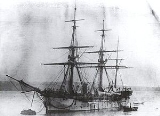
Fantome class sloop
Encyclopedia
The Fantome class was a six-ship class
of 4-gun screw composite sloop
s built for the Royal Navy
during 1873 and 1874.
, these composite sloops were obsolete before they were completed. Nevertheless, they served a useful function on the far-flung stations of the British Empire
, including participation in minor wars, such as the Perak War
. They were also used for hydrography
, and for this reason Egeria was retained until 1911.
Ship class
A ship class is a group of ships of a similar design. This is distinct from a ship-type, which might reflect a similarity of tonnage or intended use. For example, the is a nuclear aircraft carrier of the Nimitz class....
of 4-gun screw composite sloop
Sloop-of-war
In the 18th and most of the 19th centuries, a sloop-of-war was a warship with a single gun deck that carried up to eighteen guns. As the rating system covered all vessels with 20 guns and above, this meant that the term sloop-of-war actually encompassed all the unrated combat vessels including the...
s built for the Royal Navy
Royal Navy
The Royal Navy is the naval warfare service branch of the British Armed Forces. Founded in the 16th century, it is the oldest service branch and is known as the Senior Service...
during 1873 and 1874.
Construction
Fantome and her sister ships were constructed of an iron frame sheathed with teak and copper (hence 'composite').Propulsion
A two-cylinder horizontal compound-expansion steam engine provided by Humphrys, Tennant & Company powered an 11 feet (3.4 m) diameter screw. Steam was provided by three cylindrical boilers working at 60 pound per square inches (4.1 bar). The indicated horsepower varied from 836 ihp. Daring was fitted with a trunk engine provided by John Penn & Sons.Armament
The Fantome class carried two 7 inches (177.8 mm) and two 64-pounder muzzle-loading rifles, all mounted on pivots.Evaluation
Built at a time of great technological change in naval architectureNaval architecture
Naval architecture is an engineering discipline dealing with the design, construction, maintenance and operation of marine vessels and structures. Naval architecture involves basic and applied research, design, development, design evaluation and calculations during all stages of the life of a...
, these composite sloops were obsolete before they were completed. Nevertheless, they served a useful function on the far-flung stations of the British Empire
British Empire
The British Empire comprised the dominions, colonies, protectorates, mandates and other territories ruled or administered by the United Kingdom. It originated with the overseas colonies and trading posts established by England in the late 16th and early 17th centuries. At its height, it was the...
, including participation in minor wars, such as the Perak War
Perak War
The Perak War took place between British and local forces in Perak, a state in northwestern Malaysia. The sultan of Upper Perak and other local chiefs attempted to end foreign influence in the region and remove the British administrator James W.W. Birch...
. They were also used for hydrography
Hydrography
Hydrography is the measurement of the depths, the tides and currents of a body of water and establishment of the sea, river or lake bed topography and morphology. Normally and historically for the purpose of charting a body of water for the safe navigation of shipping...
, and for this reason Egeria was retained until 1911.
Ships
| Name | Ship Builder | |Launched | |Fate |
|---|---|---|---|
| Pembroke Dock Pembroke Dock Pembroke Dock is a town in Pembrokeshire, south-west Wales, lying north of Pembroke on the River Cleddau. Originally a small fishing village known as Paterchurch, the town was greatly expanded from 1814 onwards following the construction of a Royal Naval Dockyard... |
26 March 1873 | Sold 1889 | |
| Chatham Dockyard Chatham Dockyard Chatham Dockyard, located on the River Medway and of which two-thirds is in Gillingham and one third in Chatham, Kent, England, came into existence at the time when, following the Reformation, relations with the Catholic countries of Europe had worsened, leading to a requirement for additional... |
24 July 1873 | Scrapped 1889 | |
| Blackwall Yard Blackwall Yard Blackwall Yard was a shipyard on the Thames at Blackwall, London, engaged in ship building and later ship repairs for over 350 years. The yard closed in 1987... , London London London is the capital city of :England and the :United Kingdom, the largest metropolitan area in the United Kingdom, and the largest urban zone in the European Union by most measures. Located on the River Thames, London has been a major settlement for two millennia, its history going back to its... |
4 February 1874 | Sold 1889 | |
| Pembroke Dock | 1 November 1873 | Sold 1911 | |
| Chatham Dockyard | 27 November 1873 | Sold 1888 | |
| Money Wigram & Sons, Blackwall Yard | 20 October 1873 | Sold 1887 |

